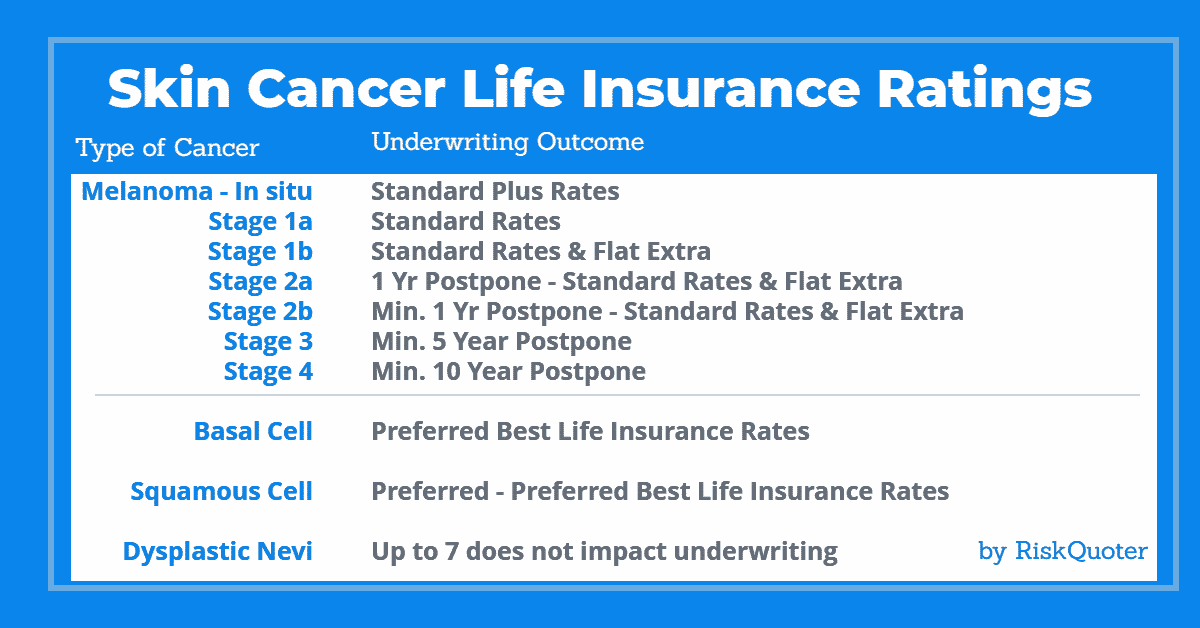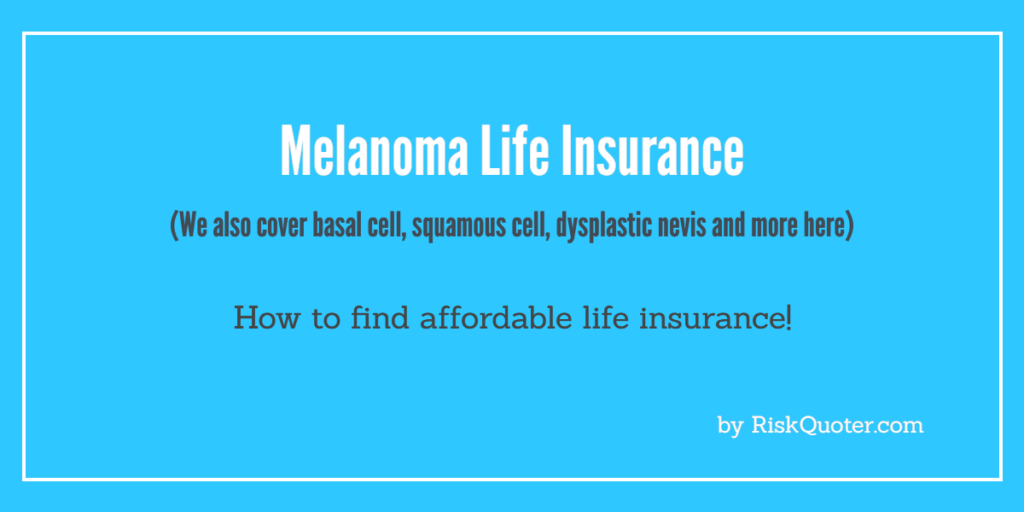A melanoma diagnosis (or any skin cancer) can be daunting, but obtaining life insurance afterward is possible. With the right approach, you can secure affordable coverage!
What You’ll Learn in This Guide
This guide covers how melanoma and other skin cancers affect life insurance, the best strategies for approval, and which insurers offer the best rates for cancer patients and survivors. You’ll learn:
- Melanoma Underwriting: How a melanoma diagnosis affects life insurance underwriting.
- Stage Specific Coverage: From melanoma in situ to advanced melanoma.
- Basal and Squamous Cell Carcinoma: How non-melanoma skin cancers affect rates.
- Insurer Insights: Which life insurers offer the best policies for melanoma survivors.
- Real-Life Examples: Actual underwriting results for applicants with a history of skin cancer.
How Melanoma and Skin Cancer Affect Life Insurance
A melanoma diagnosis does affect your life insurance premiums and eligibility. Underwriters examine several key details to determine your risk profile and rate class, including:
Type of Skin Cancer & Diagnosis Details
- What type of skin cancer did you have, and when were you diagnosed?
- Melanoma – Superficial spreading, nodular, lentigo maligna, or acral lentiginous melanoma
- Basal Cell and Squamous Cell
- Pre-Cancerous Skin Conditions – dysplastic nevi, Paget’s disease
Stage and Severity
- Stage and Severity
- What was the melanoma stage and tumor size?
- Was there any reoccurrence?
- What was the depth and thickness? (Breslow, AJCC)
- Clark’s Level thickness for cancers diagnosed before 2010.
- Were any lymph nodes cancerous? How many?
- Was the melanoma ulcerated?
Treatment and Recurrence
- Treatment History
- How was the cancer treated? Surgery, radiation, chemotherapy.
- Where on your body was the skin cancer located?
- How many times have you had skin cancer?
- Time Since Treatment
- When were you diagnosed?
- When did you start treatment?
- When did you complete all treatment?
- Do you visit your dermatologist regularly?
- Overall Health and Medical History
- Is there a family history of melanoma?
- Do you have any other health conditions?
Gathering all relevant medical information—especially pathology reports—will improve the accuracy of the underwriting feedback you receive.
By understanding these factors, we can better help you navigate the process and find the type of life insurance that suits your needs.

Life Insurance Options by Melanoma Stage
According to the American Cancer Society, doctors expect to diagnose about 105,000 melanoma cases in America in 2025.
Underwriting guidelines vary significantly based on the type, stage, treatment options chosen, and time since diagnosis and recovery.
Melanoma In Situ & Stage 1 Melanoma Life Insurance
If you were diagnosed with melanoma in situ, or Stage 1a or 1b melanoma surgically removed, life insurance is typically available immediately after surgery.
How We Helped a Client Get Life Insurance After Melanoma In Situ
Getting life insurance after melanoma in situ is surgically removed with no further treatment, a standard rate and possibly a standard plus rate are available after surgery.
For example, one of our clients had melanoma in situ (0.1mm thick) on her forehead, with a layer of skin surgically removed via Moh’s surgery. She applied with us and received the following:
- Standard Plus Rates – Banner Life, Prudential, and Mutual of Omaha
- Standard Rates – Corebridge, Lincoln Financial, John Hancock, Pacific Life, and Protective Life.
Banner Life’s rates were the best for this client.
Real-Life Example: Life Insurance After Stage T1a Melanoma
Stage T1a melanoma is less than 1mm thick and not ulcerated.
Standard life insurance rates are available after surgery with the right companies. Other companies will postpone or decline coverage.
One of our clients had a T1a melanoma surgically removed with no further complications. The following offers were received:
- Standard Rates – Prudential, Lincoln, John Hancock and Protective
- Postponed or Declined – Corebridge, Pacific Life, Banner Life
Lincoln National’s rates were most competitive for this case.
Real-Life Example: Life Insurance After Stage T1b Melanoma
Stage 1b melanomas are more severe than Stage 1a because they are thicker (over 0.8mm) and ulcerated.
While life insurance is available after surgery, rates will include a table rating or flat extra expense. As more time passes since surgery, better rates become available.
One of our clients was diagnosed with stage T1b melanoma, which was surgically removed with no further complications. He applied through us a few months after surgery and received the following:
- Standard with Flat Extra Expense – Prudential, Lincoln, Mutual of Omaha
- Table Rated Offer – Corebridge Financial at a Table 4 rating.
Corebridge Financial offered the best rate, and we believe that as more time passes, we’ll be able to get a standard rate for this client.
Stage 2 Melanoma Life Insurance
Stage 2 melanoma presents more challenges for life insurance, often requiring waiting periods and higher premiums due to the increased risk factors.
When you’ve been diagnosed with stage 2 melanoma, life insurance companies will postpone offering coverage to you for a minimum of 12 months after completing all treatment.
Most companies will add a flat extra expense for 5-7 years when life insurance is available.
Prudential, Lincoln National, and Protective Life have all been competitive companies for our clients with stage T2a or T2b melanomas.
Stage 3 Melanoma Life Insurance
Stage 3 requires lengthy postponement periods of 5 years or longer from the end of treatment. This is due to the higher risk and potential spread of cancer to nearby lymph nodes.
Companies will include a life insurance table rating and a flat extra fee when life insurance becomes available.
The table ratings typically add 50% to the standard rate for the policy’s life. The flat extra will add $1500 – $2000 per every $100,000 coverage you consider and may last 5-7 years.
Stage 4 Melanoma Life Insurance
With stage 4, the cancer has spread to other organs.
Life insurance companies will deny all coverage except for accidental death benefits and guaranteed issue insurance policies.
A graded benefit guaranteed issue policy limits coverage amounts to $25,000. Accidental death benefit coverage is available for up to $500,000.
Life Insurance for Other Skin Cancers
Life insurance rates for non-melanoma skin cancers are competitive, with some companies even willing to consider their best rate classes.
Basal Cell Carcinoma and Squamous Cell Carcinoma Life Insurance
Basal cell carcinoma (BCC) and Squamous Cell Carcinoma (SCC): These non-melanoma skin cancers are the most common and generally don’t affect life insurance eligibility. Most applicants qualify for preferred or better rates after treatment unless advanced therapies like radiation or chemotherapy-based creams are used.
In that case, you are most likely looking at a standard or standard plus rate.
Pre-Cancerous Skin Conditions & Life Insurance
For example, pre-cancerous conditions like actinic keratosis or atypical moles (dysplastic nevi) can influence underwriting.
Dysplastic Nevi is an existing mole that may resemble melanoma. People who have dysplastic nevi are at a higher risk of developing melanoma. Underwriters look at your history, the number of dysplastic nevi, and the time since removal.
Obtaining preferred rates for dysplastic nevi is possible. Most companies consider individuals with fewer than 4-6 dysplastic nevi for their preferred rates.
Similarly, actinic keratosis is a skin condition that can sometimes become skin cancer if not treated. Once treated, underwriting follows the same rules as basal cell carcinoma and sometimes squamous cell carcinoma.
FAQ About Life Insurance After Skin Cancer
We have answers if you have questions about life insurance with skin cancer.
Secure Your Future with the Right Coverage
A melanoma or skin cancer diagnosis doesn’t mean life insurance is out of reach. You can find coverage that fits your needs with the right insurer and strategy.
Request a life insurance quote today – No pressure, no obligation.
References:
Basal Cell Carcinoma Overview. Skin Cancer Foundation. https://www.skincancer.org/skin-cancer-information/basal-cell-carcinoma/ Accessed June 17, 2020.
Key Statistics for Melanoma Skin Cancer. American Cancer Society. https://www.cancer.org/cancer/melanoma-skin-cancer/about/key-statistics.html Accessed June 17, 2020
Munich American Reassurance Company. (2020). Malignant Melanoma [PDF file].
Prudential Financial, Inc. (2017) Rx for Success Skin Cancer. [PDF file].
Melanoma underwriting rate chart – compiled from multiple carriers
| Stage | Postpone? | Flat Extra | Likely Outcome? |
|---|---|---|---|
| In situ | No | No | Standard Plus |
| Stage 1a | No | No | Standard |
| Stage 1b | No | Possibly | Std + Flat Extra |
| Stage 2a* | Yes | $750 – $1000 (1) | Std + Flat Extra |
| Stage 2b* | Yes | $1000 (2) | Std + Flat Extra |
| Stage 3* | Yes | $1500 – $2000 (3) | 5 Year Postpone |
| Stage 4* | Yes | Yes (4) | 10 Year Postpone |
(1) $750 – $1000 per every $100,000 of coverage for 5 – 7 years
(2) $1000 per every $100,000 of coverage for 7+ years
(3) $1500 – $2000 per every $100,000, plus a table rating
(4) Stage 4 melanoma has a minimum 10-year postponement.
Legal & General America. (2011) Dialogue Melanoma – Issue #17 [PDF file]
AIG – American General Life Insurance Company (2014) Melanoma Data A, Thickness 1.01 – 2.0 mm [PDF file]
